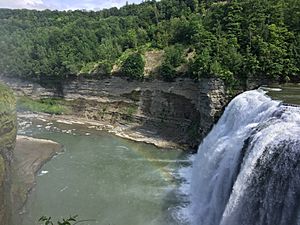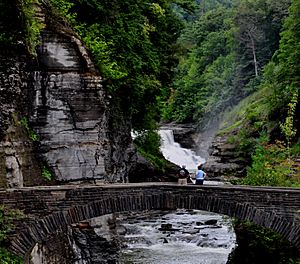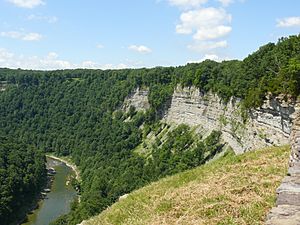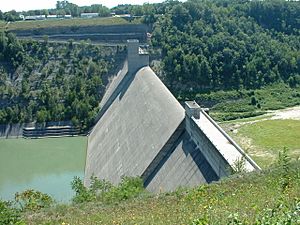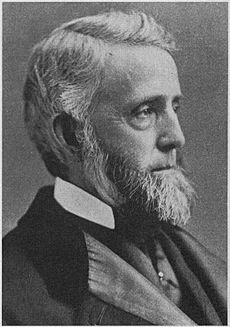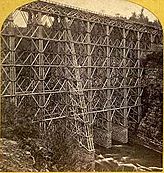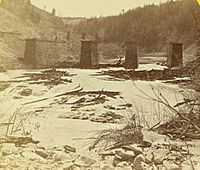Letchworth State Park facts for kids
Quick facts for kids Letchworth State Park |
|
|---|---|

View of the Middle Falls, with mist from the Upper Falls and the new Genesee Arch Bridge visible in the background
|
|
| Lua error in Module:Location_map at line 420: attempt to index field 'wikibase' (a nil value). | |
| Type | State park |
| Location | Livingston and Wyoming counties, New York, United States |
| Area | 14,427 acres (58.4 km2) |
| Created | 1906 |
| Operated by | New York State Office of Parks, Recreation and Historic Preservation |
| Visitors | 644,441 (in 2014) |
| Open | All year |
| Website | Letchworth State Park |
|
Letchworth State Park
|
|
| Architect | Letchworth, William P.; et al.; Bryant Fleming |
| Architectural style | Greek Revival, Italianate |
| NRHP reference No. | 03000718 |
| Added to NRHP | November 4, 2005 |
Letchworth State Park is a huge park in western Upstate New York. It covers about 14,427 acres (58.38 km2) across Livingston and Wyoming counties. The park is famous for its stunning natural beauty, often called the "Grand Canyon of the East."
The park stretches for about 17 miles (27 km) along the Genesee River. This river flows through a very deep gorge and tumbles over several large waterfalls. In 1859, a businessman named William Pryor Letchworth started buying land here. He built his home, the Glen Iris Estate, and in 1906, he gave 1,000 acres (4.0 km2) of his land to New York State. This gift became the start of Letchworth State Park. The park features three main waterfalls: the Upper, Middle, and Lower Falls. The gorge walls can be as high as 550 feet (170 m) in some places!
Contents
Fun Things to Do at Letchworth State Park
You can enter Letchworth State Park near towns like Mount Morris, Perry, Castile, and Portageville. A paved road runs along the west side of the gorge, offering many amazing views of the landscape.
The park has lots of facilities for visitors. You'll find picnic areas, playgrounds, and even two large swimming pools. There are also cabins and campsites if you want to stay overnight. For outdoor adventures, the park offers 66 miles (106 km) of hiking trails and trails for horse riding.
You can enjoy many activities like biking, fishing, whitewater rafting, and kayaking. If you like treasure hunts, try geocaching! During certain times of the year, you can even go hunting for wild turkey and deer. In winter, the park is great for snowmobiling, cross-country skiing, snow tubing, and horse-drawn sleigh rides. If you're feeling adventurous, you can even go hot air ballooning over the park, if the weather is good.
Letchworth State Park has won awards for being one of the best parks. In 2015 and again in 2020, USA Today readers voted it the best state park in the United States!
Amazing Waterfalls and Rock Formations
Inside the park, the Genesee River has three main waterfalls: the Upper, Middle, and Lower Falls. These are all located in the southern part of the park called Portage Canyon. There are also about 50 smaller waterfalls on creeks that flow into the river. The Middle Falls is the tallest of the three main ones.
The deep gorge carved by the river has rock walls that reach up to 550 feet (170 m) high. In some spots, the gorge narrows to just 400 feet (120 m) across. This dramatic landscape is why people call it the "Grand Canyon of the East." You can cross the Genesee River in the park on a stone bridge located just below the Lower Falls. Above the Upper Falls, there's a modern railroad bridge that was built in 2017.
Another interesting waterfall is Inspiration Falls. It's a tall, thin waterfall that drops 350 feet (110 m). However, it only flows during certain seasons, so sometimes it just looks like a wet stain on the cliff.
The rocks you see in the gorge are very old, from a time called the Devonian period. They are mostly shale, with some layers of limestone and sandstone. These rocks formed in an ancient inland sea and contain many fossils of sea creatures. The river valley itself is quite young in geological terms. It was created when the last huge glacier changed the river's path, forcing it to cut a new valley.
Historic Places and Museums
The historic Glen Iris Inn was once the home of William Pryor Letchworth. Today, it's a hotel where you can stay overnight and enjoy meals. It sits on a cliff overlooking the Middle Falls.
The park is also the burial place of Mary Jemison. She was a Scots-Irish girl captured by a French and Shawnee group when she was 12 during the French and Indian War. She was adopted by a Seneca family and chose to live with them her whole life, having seven children. Her remains were moved to the park in 1872 and placed near a Seneca Council House that Letchworth had also moved there.
You can learn more about the area at the William Pryor Letchworth Museum. It displays items collected by the park's founder. The exhibits cover the natural and cultural history of the Genesee Valley. You'll see Seneca nation artifacts, learn about Mary Jemison, early pioneers, the Genesee Valley Canal, and William Pryor Letchworth himself.
In 2016, the Humphrey Nature Center opened. This modern building is open all year and has classrooms, meeting rooms, a research lab, and a butterfly garden. It also connects to various trails.
Mount Morris Dam: Flood Protector
At the northern end of the park, you'll find the Mount Morris Dam. It was built between 1948 and 1954 by the United States Army Corps of Engineers. Its main job is to control floods on the Genesee River.
This dam is the largest concrete flood control dam of its kind east of the Mississippi River. It's 1,028 feet (313 m) long and rises 230 feet (70 m) from the riverbed. The dam proved how important it was during the Flood of 1972. It saved thousands of acres of farmland and the city of Rochester from severe flooding.
The Portage Viaduct: A Modern Bridge
The Portage Viaduct was an iron railroad bridge built in 1875. It was 820 feet (250 m) long and 240 feet (73 m) high, located near the park's Upper Falls. People used to walk on it to see the gorge, even though it was dangerous and against the rules.
In 2011, the Norfolk Southern Railway decided to replace the old bridge. A new steel arch bridge was built about 75 feet (23 m) south of the old one. This new bridge was finished in late 2017. Now, special gates stop people from walking on the bridge when a train is coming, making it much safer.
History of Letchworth Park
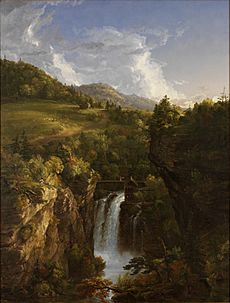
The land where the park now stands was once home to the Seneca people. They called this canyon Sehgahunda, which means "Vale of the three falls." They believed the Middle Falls, which they called Ska-ga-dee, was so amazing it could make the sun stop at midday.
William Pryor Letchworth first saw the gorge from a train in 1858. In 1859, he bought 190 acres (0.77 km2) of land near the Portage Falls. He wanted to stop plans for a hydroelectric dam that would have changed the river's flow and harmed the waterfalls. He then started creating his Glen Iris Estate, hiring a famous landscape artist to design paths, bridges, and gardens.
Letchworth kept buying more land over the years. In 1906, he gave his Glen Iris Estate and 1,000 acres (4.0 km2) to New York State. He wanted to protect the beautiful gorge and woodlands from businesses that might damage them. He also asked that the land be managed by the American Scenic and Historic Preservation Society. A plaque in the park has a poem written by his niece in 1910, which says:
God wrought for us this scene beyond compare
But one man's loving hand protected it
And gave to his fellow man to share.
George F. Kunz, who was president of the American Scenic and Historic Preservation Society, was a big supporter of the park. He helped make sure Letchworth's important library was kept safe. He also helped with the memorial for Mary Jemison in 1910.
William Pryor Letchworth passed away at the Glen Iris on December 1, 1910. He is buried in Buffalo.
During the 1930s, workers from the Civilian Conservation Corps (CCC) made many improvements to the park. They built cabins, scenic overlooks, bridges, and trails, which visitors still enjoy today.
The Old Portageville Bridge Fire
The Erie Railroad Company built a huge wooden trestle bridge over the Genesee River above the Upper Falls. Construction started in 1851, and the bridge opened in 1852. At that time, it was the longest and tallest wooden bridge in the world!
Sadly, in the early morning of May 6, 1875, this amazing wooden bridge was completely destroyed by a huge fire. Only the concrete supports were left.
The Erie Railroad Company quickly decided to replace it with an iron bridge. Construction began just a month later, on June 8, 1875. The new Portage Viaduct was ready for trains by July 31, 1875. This was an incredible building achievement for that time!
The Flood of 1972
In June 1972, a major natural disaster hit the Genesee Valley. Hurricane Agnes brought heavy rains to New York State. The ground was already wet from earlier showers, so it couldn't soak up the 6 to 12 inches (150 to 300 mm) of rain that fell. This event, known as the Flood of '72, had a big impact on Letchworth Park.
Even though the park wasn't hit as hard as some other areas, the flood caused damage that lasted for years. For example, the Lower Falls Bridge and a trail called Sugar Loaf were closed for several years. Even today, you can still see some of the natural marks left by the floodwaters from over 50 years ago. You can watch video footage of the flood's damage at the William Pryor Letchworth Museum.
Images for kids
See also


